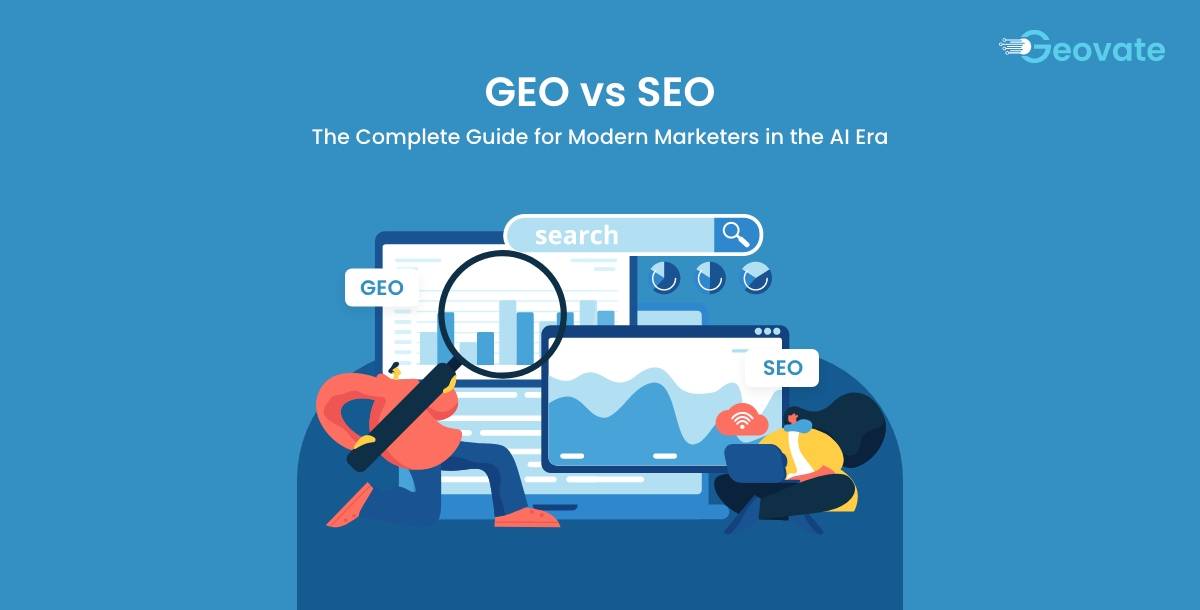GEO vs SEO: The Complete Guide for Modern Marketers in the AI Era
Fri,08 Aug 2025 11:01:00- Font Size
- Share Content

In today’s fast-changing digital world, the way people search for information is evolving faster than ever. Just a few years ago, search behavior was dominated by keyword queries and SERPs (Search Engine Results Pages). Then came conversational searches. And now, with the rise of generative AI, we’re in a new era — one where Generative Engine Optimization (GEO) is becoming just as important as traditional Search Engine Optimization (SEO).
This shift isn’t a minor tweak in marketing strategy. It’s a complete reimagining of how brands get discovered online. If you’re still relying solely on old-school SEO tactics, you risk being invisible in the places where users are now spending their time: AI-powered overviews, chatbots, and voice assistants.
At Geovate, we specialize in blending SEO services and generative engine optimization services so our clients dominate both traditional search and AI-driven discovery. In this guide, we’ll walk you through everything you need to know — from the fundamentals to advanced strategies — so you can leverage GEO services alongside SEO for maximum online visibility.
1. Understanding the New Search Landscape
For years, Google, Bing, and other search engines acted as the main gateway to online discovery. Businesses optimized for SEO to climb the rankings, win clicks, and drive traffic. But two major trends are changing the game:
1.1 The Rise of Zero-Click Searches
turn on Google’s AI Overviews and “featured snippets,” which now answer questions directly on the results page, without requiring the user to click through to a website. Studies suggest over 25% of Google searches now result in no clicks, meaning your content can be seen without generating traffic — if it’s optimized for AI-driven features.
1.2 AI Assistants as Gatekeepers
ChatGPT, Bing AI, Gemini (formerly Bard), and voice assistants like Siri and Alexa are becoming primary sources of information. These tools generate instant, conversational answers, pulling from multiple sources. If your brand’s content isn’t part of those AI responses, you’re effectively invisible to a growing segment of searchers.
This is where Generative Engine Optimization comes in.
2. What Is Generative Engine Optimization (GEO)?
Generative Engine Optimization is the process of making your content AI-friendly so that generative tools — like ChatGPT, AI Overviews, and other LLM-based platforms — can interpret, reference, and present it accurately in their responses.
Instead of just ranking in SERPs, GEO focuses on:
- AI comprehension – Ensuring your content is structured so AI can easily extract accurate, context-rich answers.
- Prompt anticipation – Designing content around the types of questions users might ask AI tools.
- Modular content – Creating concise, reusable snippets (FAQs, summaries, how-tos) perfect for AI output.
At Geovate, our generative engine optimization services go beyond technical formatting — we strategically craft and position content so it becomes the go-to reference for AI platforms.
3. SEO vs GEO: How They Compare
Aspect SEO (Search Engine Optimization) GEO (Generative Engine Optimization)
Optimization Techniques Keyword research, backlinks, page speed, mobile-first design Structuring content for AI-generated queries, schema markup, modular guides
Examples of Optimization Pillar blogs, landing pages, evergreen articles FAQs, how-tos, concise guides for AI
Value Proposition Drives consistent organic traffic and brand visibility Ensures brand presence in AI-generated answers, reducing reliance on SERPs
Scalability Requires continuous updates, fresh content, link building High accuracy with fewer frequent updates
Challenges Competing with algorithm updates and keyword rivals Predicting AI prompts and avoiding AI misinterpretation
Stage of Funnel Awareness, consideration, decision Awareness and consideration
When to Prioritize When long-term ranking and web traffic are essential When targeting AI-driven interactions and niche expertise
4. Why You Need Both GEO and SEO
Many marketers ask: "Should I focus on GEO or SEO?"
The answer is simple — you need both.
Here’s why:
- SEO ensures your site ranks high for traditional searches and captures users who prefer browsing and comparing multiple sources.
- GEO ensures your brand is mentioned and recommended directly within AI-generated answers, where users often make decisions instantly.
Think of SEO as your broad net and GEO as your high-precision spear. Combined, they cover the full spectrum of search behavior.
5. Core Strategies for Generative Engine Optimization
5.1 Structure Your Content for AI Parsing
AI models love clarity. Use:
- Short paragraphs for scannability
- Bullet points & numbered lists for steps and processes
- Clear headings (H2/H3) to segment topics
Schema markup to make your content machine-readable
5.2 Create Snippet-Ready Answers
Write compact, self-contained sections that can be lifted directly into AI summaries. For example:
Question: What is Generative Engine Optimization?
Answer: Generative Engine Optimization (GEO) is the process of making content easily discoverable and usable by AI platforms like ChatGPT and Bing AI, ensuring accurate, brand-relevant responses in generative search.
5.3 Anticipate AI Prompts
Instead of only targeting high-volume keywords, identify long-tail, conversational queries AI users might ask.
Example: Instead of “best CRM software,” also optimize for “What’s the best CRM for small e-commerce businesses in 2025?”
5.4 Use Authoritative Data & References
Generative AI favors trustworthy content. Include:
- Expert quotes
- Statistics from credible sources
- Citations from research or industry reports
5.5 Maintain Fresh, Accurate Information
AI tools often pull from the most up-to-date and factually correct content. Outdated details risk exclusion or, worse, misrepresentation.
6. How GEO Fits Into the Customer Journey
Top of Funnel (Awareness):
GEO helps you appear in AI responses when users are gathering initial information. Your concise tips, definitions, and how-tos position your brand early in the buying process.
Mid-Funnel (Consideration):
AI-driven queries often involve comparisons and solution-based searches. If your brand appears in these AI-generated lists or guides, you influence user perception before they ever reach a traditional SERP.
Decision Stage:
While GEO is strongest in the earlier stages, combining it with SEO services that include case studies, testimonials, and demos ensures a seamless journey from AI discovery to conversion.
7. Measuring GEO Success
SEO is measured through:
- Organic traffic
- SERP rankings
- CTR (Click-Through Rate)
- Bounce rates and conversions
GEO success is measured differently:
- Citations in AI tools – How often your content appears in AI-generated answers.
- Brand mentions in AI Overviews – Presence in Google’s AI summaries.
- Prompt coverage – How many anticipated AI queries your content answers effectively.
At Geovate, our GEO services include monitoring AI-generated outputs to track brand presence and identify optimization opportunities.
8. The Future of GEO and SEO
Generative AI isn’t a fad — it’s the future of how users will consume information. Just as mobile-first indexing became non-negotiable, optimizing for AI will soon be standard practice.
Key trends to watch:
- Voice search integration – GEO and SEO strategies will merge with voice AI optimization.
- Hyper-personalized AI outputs – Content tailored for micro-audiences based on user history.
- Real-time content updates – AI tools integrating live data feeds for even more accurate answers.
Businesses that adopt both generative engine optimization services and search engine optimization now will be years ahead of the competition.
9. How Geovate Can Help
At Geovate, we specialize in building unified strategies that combine SEO services and GEO services to ensure your brand is discoverable everywhere your audience searches — whether on Google’s SERPs or inside AI chat interfaces.
Our approach includes:
- Comprehensive SEO audits – Ensuring your site meets every technical and content benchmark.
- GEO content frameworks – Structuring your content so AI tools can reference it with accuracy.
- Prompt-mapping strategies – Anticipating user queries and crafting responses to match.
- Authority building – Leveraging citations, expert insights, and unique data to earn AI trust.
We don’t just optimize for algorithms — we optimize for the future of search.
Final Thoughts
The line between traditional search and AI-driven discovery is fading. To stay relevant, brands must adapt now. Generative Engine Optimization and Search Engine Optimization are two sides of the same coin — one ensures visibility in SERPs, the other secures your presence in AI-driven experiences.
By blending these approaches, you can meet your audience wherever they search — and ensure your message isn’t just seen but remembered.
If you’re ready to future-proof your online presence, Geovate’s GEO services are your competitive edge.
Contact us today to learn how we can help you dominate both the SERPs and the AI conversation.
